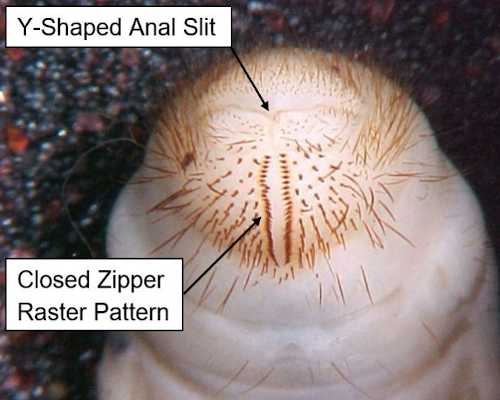By Christian Tollini
White grubs are a very common pest of turfgrass, causing damage to lawns and golf courses all over Michigan. White grubs can be a pest in many field crops as well, affecting crops such as corn, small grains, soybeans, potatoes and forage crops.
White grubs are the larvae of several different species of scarab beetles. June beetles, Japanese beetles, European chafers, Asiatic garden beetles and Aphodius (manure) beetles are all species whose larvae have been associated with damage in Michigan field crops. White grubs damage crops by feeding on the root hairs or completely severing roots, causing yield losses from stunted crop growth and stand loss.
Identifying the species of white grub present in a field is critical for determining a course of action because different species have different life cycles. June beetles have a three-year life cycle. Adult June beetles lay eggs in the soil in the spring. After eggs hatch in three to four weeks, the larvae will proceed to feed on roots of plants present in the soil. As temperatures cool, the grubs will burrow deeper into the soil to overwinter. As temperatures warm in the spring, grubs return to shallower zones in the soil to feed for another growing season.
Grubs will overwinter again, but in the following spring they will enter the pupal stage and remain in the soil for the rest of the year. Adults emerge from the soil the following spring, mate and will return to the soil to lay eggs, completing their life cycle. June beetle grubs can cause crop damage year-round because larvae feed on crop roots the entire length of the growing season.
Most of the other pest grubs in Michigan have an annual life cycle. Grubs emerge from eggs in mid-summer, larvae feed on crop roots through fall, overwinter in the soil and begin feeding again in early spring. Early in the summer, the larvae pupate and emerge from the soil as adults. Adults will lay eggs in the soil in mid-summer. Crop damage from grubs of these species is typically limited to the fall and spring, ending when adults emerge. A few species, like the Japanese beetle and Asiatic garden beetle, also cause crop damage in their adult stage in the summer by feeding on the foliage of crops.
Grub species can be identified by the raster pattern (a pattern of spines) and the shape of the anal slit. Each species has a unique combination of raster pattern and anal slit shape. Michigan State University Extension entomologist Chistina DiFonzo developed a handy field ID sheet for identifying grub species.

When identifying white grubs, observe the raster pattern and anal slit of the grub. This grub has a Y-shaped anal slit and a raster pattern that resembles a zipper, indicating that it is the larvae of a June beetle.
In northern Michigan, June beetle larvae are the only recorded cause of grub damage. However, Japanese beetles are present in the area as well. Grubs prefer feeding on the roots of grass species but can cause damage to legumes and young ornamental trees as well. Damage is most prevalent on sandy soils, perhaps due to higher prevalence of grubs on sandy soil as well as a higher likelihood of crop moisture stress. Sandy hillsides are common areas for grub damage to occur. Pastures and cropping systems that utilize perennial grasses, no-till or reduced till fields, and overwintering cover crops create a favorable environment for grub survival and are at higher risk for grub infestation.
Unfortunately, no rescue treatments exist for white grubs in field crops. If your cropping system or soils are favorable for grub infestation, it is strongly suggested to scout for grubs before planting. Randomly sample multiple locations across the field by digging 2 square feet of soil surface up to a depth of 6 inches. It is important to identify the species found to determine if it is a multiyear or annual species because annual grubs will pupate and stop feeding. Two or more grubs per cubic foot is a general threshold
If a grub infestation exists, tillage can be a helpful tool to manage grub populations. Tillage physically kills grubs and exposes them to their natural predators, which include birds and some rodents. Delaying planting until after annual grubs pupate may also be advised to prevent losses in a particular year, however this may not help manage damage from June beetle grubs due to their multi-year life cycle. Using a soil-applied insecticide at planting can reduce grub populations when banded or placed in furrow through the planter. In corn, neonicotinoid insecticide seed treatments have little impact on grub damage, except for when used at the highest rates of 1250.
Source : msu.edu